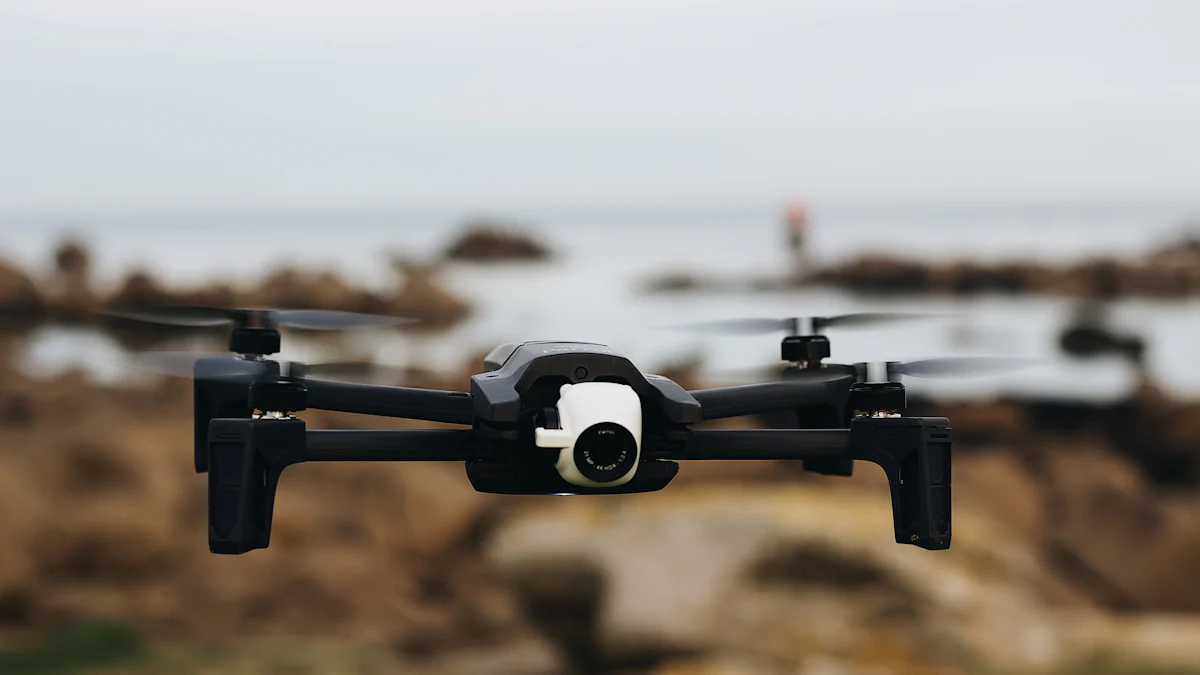Understanding the DJI Zenmuse XT Thermal Drone Camera: A Complete Guide

Exploring the Basics of the DJI Zenmuse XT Thermal Drone Camera
What is a Thermal Drone Camera?
Thermal drone cameras are specialized devices equipped with thermal imaging sensors that detect and capture heat signatures emitted by objects and environments. Thermal imaging technology operates by detecting the infrared radiation emitted by objects, which is then translated into visible images based on temperature variations. The resulting thermal imagery provides valuable insights into heat distribution, making it particularly useful for various applications.
Understanding Thermal Imaging
Thermal imaging involves capturing the infrared radiation emitted by objects and converting it into visible images. This process allows users to visualize temperature variations in their surroundings, enabling them to identify hotspots, cold areas, and everything in between. The ability to detect these temperature differences makes thermal imaging an invaluable tool for numerous industries and activities.
The Role of Thermal Cameras in Drones
Thermal cameras play a crucial role in enhancing the capabilities of drones by providing them with the ability to capture thermal imagery from aerial perspectives. By integrating thermal drone cameras like the DJI Zenmuse XT, drones can be used for tasks such as search and rescue operations, infrastructure inspections, firefighting support, and environmental monitoring. The combination of drone technology with thermal imaging capabilities significantly expands the range of applications where aerial data collection is beneficial.
An Overview of the DJI Zenmuse XT
Technical Specifications
The DJI Zenmuse XT is equipped with a high-resolution thermal sensor that captures detailed thermal imagery with exceptional clarity. Its technical specifications include a wide temperature measurement range and various color palettes for visualizing heat sources. These features make it a versatile tool for professionals across different industries who require precise thermal data for their operations.
Compatibility with DJI Drones
The DJI Zenmuse XT is designed to seamlessly integrate with DJI's Matrice series drones, ensuring compatibility and optimal performance when conducting aerial thermal inspections and surveys. This compatibility enhances the efficiency and effectiveness of drone operations by providing access to high-quality thermal imaging capabilities.
Key Features and Capabilities
Now, let's delve into the key features and capabilities that make the DJI Zenmuse XT thermal drone camera a powerful tool for capturing thermal imagery from aerial perspectives.
High-Resolution Thermal Sensor
The DJI Zenmuse XT is equipped with an advanced high-resolution thermal sensor that enables it to capture detailed thermal imagery with exceptional clarity. This cutting-edge sensor technology allows users to detect and visualize heat signatures with precision, providing valuable insights into temperature differentials across various environments.
Capturing Detailed Thermal Imagery
The high-resolution thermal sensor of the DJI Zenmuse XT empowers users to capture intricate details within thermal images, ensuring that no critical information is overlooked during aerial inspections or surveys. This capability is particularly beneficial for professionals in industries such as infrastructure maintenance, environmental monitoring, and public safety, where precise thermal data is essential for decision-making processes.
Real-Time Thermal Imaging
One of the standout capabilities of the DJI Zenmuse XT is its ability to provide real-time thermal imaging during drone operations. This feature allows users to receive live thermal feed from the camera, enabling them to make immediate assessments and decisions based on current thermal data. Real-time thermal imaging enhances situational awareness and responsiveness in scenarios such as search and rescue missions, firefighting support, and emergency response efforts.
Color Palettes for Thermal Imaging
The DJI Zenmuse XT offers a range of customizable color palettes specifically designed for visualizing heat sources in diverse environments. These color palettes enable users to tailor their thermal imagery representation according to their specific needs and preferences, enhancing the interpretability of thermal data.
Visualizing Heat Sources
With its customizable color palettes, the DJI Zenmuse XT allows users to visually highlight heat sources in varying shades and intensities. This capability facilitates the identification of anomalies, hotspots, or temperature differentials within a scene, making it an invaluable tool for detecting potential issues or hazards across different applications.
Applications in Various Industries
The versatile color palettes provided by the DJI Zenmuse XT cater to a wide range of industries and applications. From building diagnostics and energy audits to wildlife monitoring and precision agriculture, these color palettes enhance the applicability of thermal imaging in addressing industry-specific challenges.
Practical Applications of Thermal Drone Imaging
Thermal drone imaging has revolutionized various industries by offering innovative solutions for critical operations. Let's explore some practical applications where the utilization of thermal drone cameras, such as the DJI Zenmuse XT, has made a significant impact.
Search and Rescue Operations
How Thermal Imaging Saves Lives
In search and rescue operations, time is often of the essence, and the ability to swiftly locate individuals in challenging environments can be a matter of life and death. Thermal drone imaging plays a pivotal role in these scenarios by enabling responders to detect heat signatures emitted by individuals, even in low-visibility conditions or dense foliage. The capability to identify human body heat from an aerial perspective enhances the efficiency and effectiveness of search and rescue efforts, ultimately contributing to saving lives.
Real-World Success Stories
Real-world success stories abound regarding the use of thermal drone imaging in search and rescue missions. For instance, emergency response teams have successfully located lost hikers in remote areas by leveraging thermal drones to pinpoint their exact locations based on body heat signatures. Additionally, during natural disasters such as earthquakes or avalanches, thermal drones have been instrumental in identifying survivors trapped under debris or snow, facilitating timely and targeted rescue operations.
Infrastructure Inspection and Firefighting
Preventing Disasters Before They Happen
Thermal drone imaging serves as a proactive tool for infrastructure inspection, allowing professionals to identify potential issues before they escalate into critical failures. By conducting aerial thermal surveys of structures such as bridges, buildings, and power lines, inspectors can detect anomalies related to heat differentials that may indicate structural weaknesses or electrical malfunctions. This preventive approach helps mitigate risks associated with infrastructure failures and contributes to ensuring public safety.
Enhancing Firefighting Strategies with Thermal Imaging
In firefighting scenarios, thermal drone cameras provide firefighters with valuable insights into the behavior and spread of fires. By capturing real-time thermal imagery from above the fire zone, responders can assess temperature variations within the affected area and identify hotspots that require immediate attention. This information empowers firefighting teams to strategize their efforts more effectively, allocate resources efficiently, and prioritize areas for containment or suppression based on accurate thermal data.
The integration of thermal drone imaging technology into these critical applications demonstrates its immense value in enhancing operational capabilities across diverse sectors. Whether it's aiding in life-saving missions during emergencies or proactively safeguarding infrastructure integrity, the DJI Zenmuse XT thermal drone camera continues to prove its significance as a versatile tool for addressing complex challenges.
Now let's move on to comparing the DJI Zenmuse XT with other thermal cameras available in the market.
Comparing DJI Zenmuse XT with Other Thermal Cameras
When considering thermal imaging solutions, it's essential to explore the features and capabilities of different thermal cameras available in the market. In this section, we'll compare the DJI Zenmuse XT with two other notable options: the FPV Thermal Camera and the iSun analog FPV thermal camera.
FPV Thermal Camera
Features and Benefits
The FPV Thermal Camera is renowned for its compact design and lightweight construction, making it an ideal choice for applications that require agility and maneuverability. Its portability allows for seamless integration with various drone models, enabling users to capture thermal imagery from versatile aerial perspectives. Additionally, the FPV Thermal Camera offers real-time transmission of thermal data to ground stations, providing immediate access to critical information during missions or inspections.
In terms of image quality, this thermal camera boasts a high-resolution sensor that delivers detailed thermal imagery with exceptional clarity. The ability to capture intricate details within thermal images makes it suitable for tasks such as infrastructure monitoring, wildlife conservation, and emergency response operations. Furthermore, its user-friendly interface and intuitive controls contribute to a streamlined user experience, allowing operators to focus on their objectives without unnecessary complexity.
Limitations and Considerations
While the FPV Thermal Camera offers impressive features, it's important to consider certain limitations when evaluating its suitability for specific use cases. One aspect to note is its temperature measurement range, which may be more limited compared to other advanced thermal cameras. This consideration is particularly relevant for applications that require precise temperature data across a wide spectrum. Additionally, users should assess the compatibility of the FPV Thermal Camera with their existing drone platforms to ensure seamless integration and optimal performance.
iSun Analog FPV Thermal Camera
A Closer Look at iSun's Capabilities
The iSun analog FPV thermal camera stands out for its robust construction and durability, designed to withstand challenging environmental conditions encountered during aerial operations. Its rugged build makes it well-suited for demanding applications such as industrial inspections, agricultural surveys, and security patrols where resilience is paramount. Moreover, this thermal camera offers enhanced flexibility in terms of adjustable settings and customizable parameters, empowering users to fine-tune their thermal imaging preferences according to specific operational requirements.
Choosing the Right Thermal Camera for Your Needs
Selecting the most suitable thermal camera involves assessing individual needs and aligning them with the unique features offered by each option. Factors such as operational environment, required image resolution, temperature measurement range, and compatibility with existing equipment should all be taken into account when making an informed decision. It's essential to prioritize functionalities that directly contribute to achieving desired outcomes while considering any potential trade-offs based on specific use case scenarios.
Final Thoughts
As we look to the future of thermal drone imaging, it's evident that ongoing innovations in technology will continue to shape the capabilities and applications of thermal cameras for aerial perspectives.
The Future of Thermal Drone Imaging
Innovations on the Horizon
The field of thermal drone imaging is poised for significant advancements, driven by continuous research and development efforts aimed at enhancing sensor technologies, data processing capabilities, and overall system integration. One area of innovation focuses on further improving the resolution and sensitivity of thermal sensors, enabling them to capture even finer details within thermal imagery. This advancement holds promise for industries such as precision agriculture, where the ability to discern subtle temperature differentials can provide valuable insights into crop health and environmental conditions.
Another exciting prospect lies in the integration of artificial intelligence (AI) algorithms with thermal imaging systems, enabling automated analysis and interpretation of thermal data. By leveraging AI-driven analytics, users can gain deeper insights into complex thermal patterns and anomalies, facilitating more informed decision-making processes across various applications. Additionally, advancements in real-time data transmission and augmented reality interfaces are expected to enhance the user experience by providing seamless access to critical thermal information during missions or inspections.
Making an Informed Decision on Thermal Cameras
When considering the adoption of thermal cameras for aerial imaging applications, it's essential for users to make informed decisions based on their specific operational requirements and industry needs. Factors such as sensor resolution, temperature measurement range, compatibility with existing drone platforms, and post-processing capabilities should all be carefully evaluated when selecting a thermal camera solution.
To aid in this decision-making process, it's beneficial to create a checklist or criteria framework that aligns with the intended use cases and desired outcomes. This may include considerations such as image clarity requirements, environmental operating conditions, regulatory compliance standards, and long-term scalability of the chosen thermal camera solution.
Ultimately, staying informed about emerging trends and technological advancements in the field of thermal drone imaging is crucial for making strategic investments in equipment that align with evolving industry demands. By keeping abreast of new developments and engaging with industry experts and communities, users can position themselves to leverage cutting-edge thermal imaging solutions that drive operational efficiency and innovation.
In conclusion, as technology continues to evolve at a rapid pace, the future holds immense potential for advancing the capabilities of thermal drone imaging systems. By embracing these innovations and making well-informed decisions when selecting thermal cameras, professionals across diverse industries can harness the power of aerial thermal imagery to address complex challenges with confidence and precision.
See Also
Mastering Aerial Photography Using Analog FPV Thermal Cameras: An In-Depth Manual
Becoming an Expert in Aerial Surveillance: The ISUN Thermal Camera Tutorial
Perfecting Aerial Monitoring with Thermal Imaging Camera Drones: A Detailed Handbook
Optimizing Aerial Surveillance with Analog FPV Thermal Camera: A Complete Manual
Mastering Technology of FPV Thermal Cameras: The Definitive Guide to Choosing Top Drones
Contact Us: Ms. Coco Huang
E-mail: sales@iasun.cn
WhatsApp/Wechat: +86 13510421923

